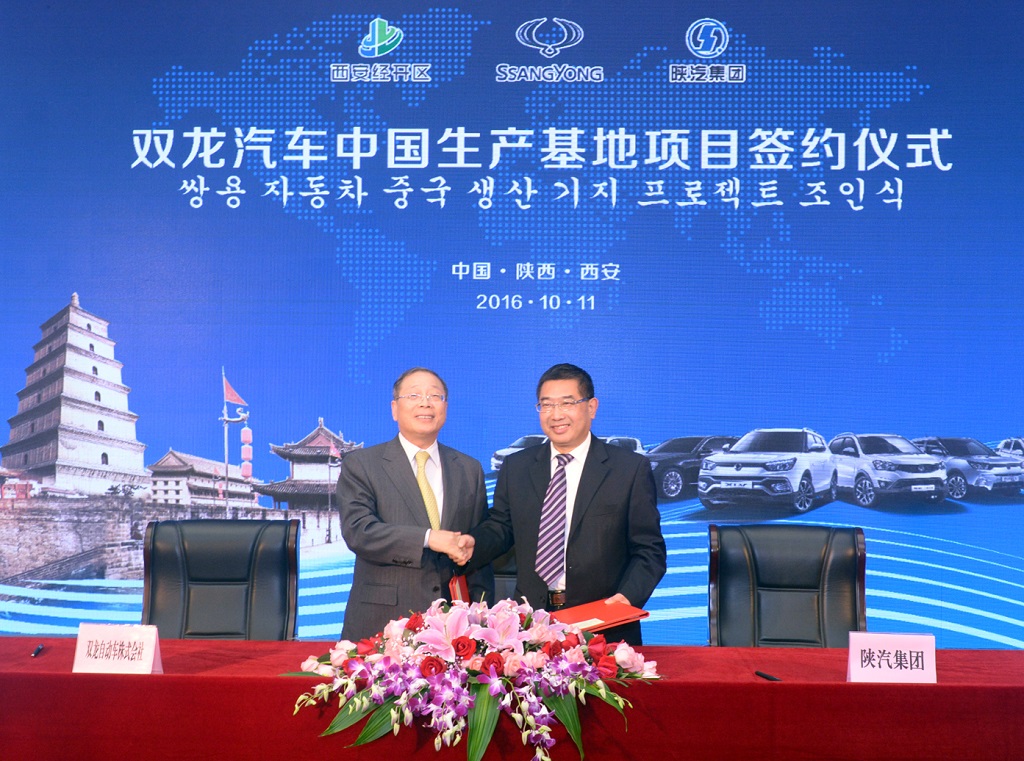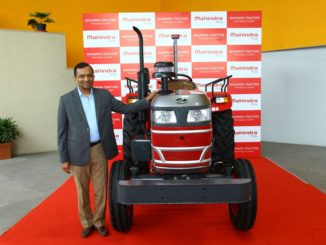 AGM Chairman’s Speech – M&M Annual General Meeting
AGM Chairman’s Speech – M&M Annual General Meeting
Ladies and gentlemen,
Welcome to the 70th Annual General Meeting of your Company.
The Annual Report has reached all of you, so I will not repeat what you have already read.
In spite of all the challenges in the recent past, we have delivered half a million vehicles worldwide, increased our sales revenues and maintained our position as India’s largest tractor Company and India’s largest Utility Vehicle manufacturer. And our Q 1 results too, show we are on the upswing.
Gross Revenues and Other Income of the Company together with MVML is Rs. 11961 crores as against Rs. 10,478 crores during the corresponding period last year, a growth of 14 per cent. The Net Profit of the quarter is Rs. 962 crores as against Rs. 830 crores of the corresponding quarter last year, a growth of 16%.
All in all, we have kept our head above water in very challenging circumstances, and have taken many measures to lay the foundations for the future. And I believe that that future is just around the corner.
Why do I say this? The global scenario in 2015-16 has been uncertain and unpredictable to say the least. Global conflicts, the migrant crisis, the new twists and turns to the terrorism tale, the unexpected Brexit result, concerns about Eurozone economies, currency devaluation by China, tension in the South China Sea – the list of unforeseeable and almost unbelievable developments goes on and on.
Against this background of turmoil and turbulence, India stands out by contrast. As our Chief Economist put it in a recent presentation to the Group Executive Board, India is, in the words of the old song, “Singing in the Rain”. At the macro level, the indicators are going in the right direction. There has been a sharp rise in public spending on infrastructure, Consumer demand is rising. The rain gods this year are smiling on us and the monsoon is reasonably well distributed in most key states. So we are seeing an uptick along many key indicators like consumer sales and retail loans. In our own business, the sale of back hoes and construction equipment is increasing. The number of trucks being sold shows that owners are buying trucks for fleet expansion and not just replacement. I see definite signs of an infrastructure led recovery, a recovery that is also being driven by increased consumption and a good monsoon.
Externally, because India’s relative stability, inward FDI flows are growing. Despite Brexit and other disruptions, the Indian rupee is relatively stable. And against the background of growing global uncertainty, the growth forecasts for India are being revised upwards by analysts everywhere.
After what seems like a very long time, I am confident that India is turning the corner, even if things appear gridlocked in the rest of the world. The government has been doing the right things and reforms have been proceeding in a measured fashion. Many important initiatives like financial inclusion and large scale irrigation plans are quietly but successfully being implemented and their effects are beginning to kick in. In 1991, a new liberalized India was born. I believe 2016 will propel India to reach its true potential. After the sweeping FDI reforms in June, the Rajya Sabha passed the landmark GST Bill last week, which I truly believe will unleash the ‘caged tiger’ – India’s huge common market – which for inexplicable reasons, we had kept divided. As the recovery strengthens, I am optimistic that private investment, which is lagging today, will make a comeback, and we will soon have an environment that encourages the joys of risk taking. It is a time for the return of optimism.
Nevertheless, it’s too early to celebrate. The one fear that keeps me up at night is that once things look up, we will become complacent. And, as a result, we will always be hostage to the next round of failed monsoons. Even today, in the second decade of the twenty first century, we scan the skies each year as anxiously as our forefathers did, two centuries ago. Every failed monsoon takes us one step forward two steps back. To me, monsoon proofing our economy is crucial if we are to continue to move steadily forward. We are moving in that direction. The government has made irrigation and drought-proofing a priority. 2.85 million hectares will be brought under irrigation through the flagship Pradhan Mantri Krishi Sinchayi Yojana scheme in 2016-17. Rs. 86,500 crores will be spent over the next five years on the Accelerated Irrigation Benefits Programme. But our goal has to be even more ambitious than that. We must aim for complete Swaraj from the volatility of the monsoons. Rainwater harvesting. Water conservation. More crop per drop. Maximisation of irrigation efficiency and water productivity. Eliminating water theft. It’s a battle that needs to be fought on many fronts because monsoon proofing ourselves is a vital foundation for the nation’s future growth.
And where would the future growth of your company lie? We are in the mobility business and there is a great deal of cogitation and speculation around the world these days on the ‘Future of Mobility.’ This is a subject I have addressed in the past and will speak more on in the future, but I think it may be fitting to say a few words about Mahindra’s perceptions and aspirations in this sphere.
The buzz about the future of mobility is centered around three topics, a) Shared mobility b) the role of renewable energy-powered vehicles and c) Autonomous vehicles. Let me provide some of our perspectives on all three.
Almost a year ago, during the launch of the TUV 3OO, I had commented on how the focus of younger consumers would be on ACCESS as opposed to the ACQUISITION of cars, and that shared mobility was a development that manufacturers would have to contend with. I had said that there would be 2 segments – those cars that were price and value driven and could ultimately be shared by many people, as mobility-sharing platforms are demonstrating, and those that were high-end, exclusive and symbols of the owner’s status and aspirations. I remember being trolled on Twitter for being afraid and seeing this as a threat. However, I was merely recognizing reality and suggesting that we would have to adjust our product and capacity plans to thrive under that new reality. Since then, I do not believe anyone doubts the inevitability and imminence of that reality.
Mahindra is investing in the future of mobility by combining our innovative manufacturing capabilities with our investments in downstream platforms. While we have products in our stable today and in our pipeline that will appeal to the mobility-sharing companies, I also believe manufacturers need to take a share of the profit pool of these downstream platforms. Mahindra is doing that not just by investing in them — as we have done in the U.S with Scoot networks – but also by incubating unique and differentiated platforms ourselves. For example, our SmartShift initiative for LCVs enables people who want to transport cargo and transporters who have vehicles on offer to find each other, and work out mutually beneficial deals. Our Trringo business is revolutionising the tractor industry by enabling farmers to hire tractors for short periods of time, bringing mechanisation within the reach of every small farmer. The shared economy is no longer in the future – it is here.
As for renewable energy power trains, I need hardly tell you that Mahindra has made a pioneering bet on this by our acquisition of Reva, and our evangelizing of electric vehicles, both through our products and our participation in the new Formula E racing series, is evidence of that. We believe that as battery costs come down, the economics of electric vehicles will be irresistible for shared mobility fleets, even as high performance electric cars sustain mindshare. We fully intend to be profitable participants in this new world.
And finally, the talk and speculation about autonomous “driverless” vehicles has also accelerated. Opinion is greatly divided about the imminence of such vehicles on global roads. I believe that the technology is closer than we imagined. But their use will first occur in ring-fenced ‘circuits’ almost like shuttle routes. These could be located in city centres or tourist monument venues, or in some dedicated freight corridors.
At our management board meetings, I have stressed, in the recent past, that using the strength of our telematics skills in the larger Mahindra Group, we must focus strongly on developing autonomous, driverless commercial vehicles. Elon Musk’s recent new plans support that approach.
And I also believe that the most fertile ground – pardon the pun- for autonomy is in agricultural tractors. This is something that has not been emphasised enough globally. This is an area where productivity increases are sorely needed to feed the growing needs of the world. It is also an area where paranoia about accidents and collisions is virtually non-existent. Tractors that operate autonomously could change the future of food production. This is an area where Mahindra, as the largest tractor producer in the world, intends to play a pioneering role.
Everyone in the world is speculating whether conventional mobility companies will survive in a transformed environment. I am not an astrologer and can’t provide guarantees on that score, but I did want to emphasize to you all today, that if anyone is preparing feverishly for a disruptive future of mobility, it is Mahindra.
And I hope you will all be our partners in that future

